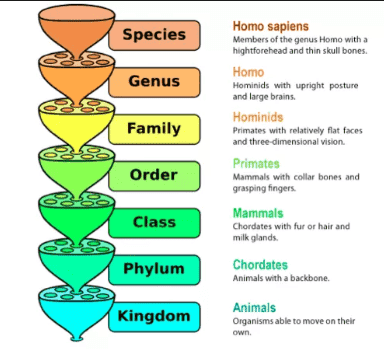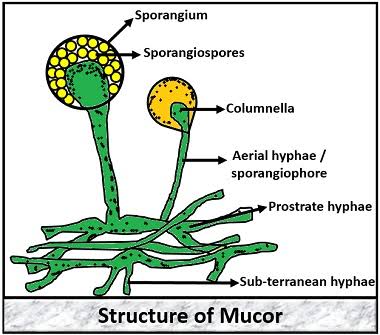A.Classification
Division-Pteridophyta
Class-Pteropsida
Order-Marsileales
Family-Marsilaceae
Genus-Marsilea
The genus marsilea comprises about 58 living species. The genus is worldwide in distribution and is very common in warmer part of the world. The species of marsilea are aquatic or amphibious plants- they grow either completely sub-merged in water, or partly or wholly out of water with their roots embedded in the muddy soil. In India only 9 living species are found or occur. The common Indian species are- M.brachypus, M.condenseta etc.
B. Structure of sporophytes
1. External structure:-
The sporophytes, i.e., the plant body is diffrentiated into stem,leaves and roots.
Stem-
Stem consists of an elongated stolon- like rhizome with distinct nodes and internodes.
Rhizome grow either on the surface of the soil or slightly embedded in the muddy soil. The stem is freely branched.
Leaves-
Leaves are long petioled and compound developing at the nodes. They are arranged alternatively in two rows along with upper side of the rhizome. Petiole of each leaves bears 4 terminal leaflets which are apparently quadrifoliate. The veins of the leaflets are dichotomously branched.
Roots-
Roots arise from the undesirable
Of the stem at the nodes. The roots are unbranched, adventious type and arise in one or two clusters.
2. Internal structure:-
T.S of stem- The T.S of stem i.e., rhizome shows the following structures.
Epidermis- Epidermis- is singled layered. The epidermal layer lacks of stomata.
Cortex- Cortex is differentiated in two three regions-
2. Spore formation- Marsilea is a hetrosporous. Two types of spores ( microspores and megaspores) develop with in their respective sporangia ( microsporangia and megasporangia respectively). These sporangia are borne within the specialized reproductive structure known as sporocarp.
At this stage of spore development, the sporocarp gets detached from the plant and remain in water or muddy soil. Soon, the sporocarp open into two halves and the sporangia are set free.
Stem consists of an elongated stolon- like rhizome with distinct nodes and internodes.
Rhizome grow either on the surface of the soil or slightly embedded in the muddy soil. The stem is freely branched.
 |
| Source Wikipedia |
Leaves-
Leaves are long petioled and compound developing at the nodes. They are arranged alternatively in two rows along with upper side of the rhizome. Petiole of each leaves bears 4 terminal leaflets which are apparently quadrifoliate. The veins of the leaflets are dichotomously branched.
Roots-
Roots arise from the undesirable
Of the stem at the nodes. The roots are unbranched, adventious type and arise in one or two clusters.
2. Internal structure:-
T.S of stem- The T.S of stem i.e., rhizome shows the following structures.
Epidermis- Epidermis- is singled layered. The epidermal layer lacks of stomata.
Cortex- Cortex is differentiated in two three regions-
- Outermost regions composed of parenchymatous cells with large radiating air spaces. The air space are traversed by single rows of cells,
- Middle regions composed of thick wall sclerenchymatous cells, and
- Innermost region composed of thin walled parenchymatous cell containing starch.
Stele- Stele of stem is actinostelic type. It is bounded on both inner and outer sides by single rows of endodermis. It consists of a single rows of xylem vessels, bounded of both sides by phloem cells.
Pith- The centermost portion of the stem is occupied by central pith. The pith is generally parenchymatous, but become sclerotic in the species growing in dry or wet soils.
T.S of Root- The root in transverse section shows-
Epidermis- Epidermi is singled layered, beneath which lies the singled layered hypodermis.
Cortex- Cortex is massive and composed of two regions-
- Outer regions composed of parenchymatous cells with prominent air spaces, and
- And inner regions made of sclerotic cells.
Stele- Stele is monarch or diarch with prostele, with exarch xylem. The phloem lies in the form of bands on either side of the xylem plate. The Stele is surrounded by single layered pericycle and endodermis on outer side.
C. Reproduction
The sporophytic of marsilea reproduce both by vegetative means and by production of spores-
1. Vegetative Reproduction- In M.hirsuta, a special reproductive structures known as tubes are developed from the plant body. These tubers remain viable during unfavorable condition, and each germinates into a new plant under favourable condition.
2. Spore formation- Marsilea is a hetrosporous. Two types of spores ( microspores and megaspores) develop with in their respective sporangia ( microsporangia and megasporangia respectively). These sporangia are borne within the specialized reproductive structure known as sporocarp.
Sporocarp are bisporangiate i.e., they contain mega and microsporangia. The sporocarp are borne either singly or in clusters on short lateral branches of the petiole, known as pedicels. Young sporocarp are soft, green and covered with hair. Mature sporocarp are brown or dark-brown in colour , hard and nut like .
The mature sporocarp is covered by 3 layered, thick and resistant wall-
- Outer wall known as epidermis in which stomata are present.
- Next to the epidermis is middle wall known as hypodermis
- The innermost wall is made of parenchymatous cells.
Beneath the wall, the sori arranged in alternating rows in the cavity of the sporocarp. Each sorus is bounded by an indusium. Both micro and mega sporangia are provid with single layer of jacket cells without annulus. Within the jacket layer, 2-3 layer of sporogenous cells are present.
Within the microsporangium, microspore mother cells developed from the sporogenous cells. All the microspore mother cells by two successive divisions form 64 microspore.
In case of megasporangium , all the megaspores mother cells , developed from the sporogenous cells disintegrate except one remain functional megaspore mother cells. This functional megapore mother cells by meiotic divisions give rise to 4- megaspore of these megaspores only one megaspores survives. Surviving megaspores become large and develops a very thick wall.
At this stage of spore development, the sporocarp gets detached from the plant and remain in water or muddy soil. Soon, the sporocarp open into two halves and the sporangia are set free.
 |
| Source Wikipedia |
D.Structure of gametophyte
Both the types of spores are liberated from their respected sporangia when the wall of the sporangia and indusia undergo gelatnization. Germination of microspores and megaspores starts as soon as they come in contact with water, resulting in the starting of the gametophytic phase of the life cycle.
1. Male gametophyte- Microspore is the first cell of the male gametophyte. Germination of Microspore starts as soon as liberated from the microsporangia.
At first the Microspore nucleus divides into two, forming small prothallial cell and the larger apical cell. The apical cell then transversely, forming two cells, each representing antheridial initial. The nucleus of each anheredial initials divide and re-divide forming a jacket of three externals cells and one spermatogenous cell, and primary androgonial cells by four successive divisions give rise to 16 androcytes or sperm mother cells. The sperm mother cells metamorphsed into spirally coiled, multiflagellate sperms. Mature sperms are set free when spore wall bursts.
2. Female gametophyte- Megaspores is the first cell of the gametophyte. Germination of megaspores starts as soon as it is liberated from the megasporangium.
At first, the megaspores nucleus divides into two, farming a smaller apical cell and a larger basal cell. The gametophyte proper develop from the smaller apical cell.
Mature female gametophyte is much reduced structure and it's consist of single archegonium embedded in a cap of tissue attached over the Apex of large nutritive cell.
The archegonium is short but broad and consists of a venter and neck . The neck consist of a neck canal cell and venter consist of a ventral canal cell and egg cell.
3. Fertilization- It takes place when the sperm swim towards an archegonium, and only one sperm enters through the neck and fuse with the egg. As a result of fusion, a diploid zygote (2n) is formed.
As soon as the zygote is formed, it develops into diploid sporophytic generation.
2. Female gametophyte- Megaspores is the first cell of the gametophyte. Germination of megaspores starts as soon as it is liberated from the megasporangium.
At first, the megaspores nucleus divides into two, farming a smaller apical cell and a larger basal cell. The gametophyte proper develop from the smaller apical cell.
Mature female gametophyte is much reduced structure and it's consist of single archegonium embedded in a cap of tissue attached over the Apex of large nutritive cell.
The archegonium is short but broad and consists of a venter and neck . The neck consist of a neck canal cell and venter consist of a ventral canal cell and egg cell.
 |
| source Wikipedia |
3. Fertilization- It takes place when the sperm swim towards an archegonium, and only one sperm enters through the neck and fuse with the egg. As a result of fusion, a diploid zygote (2n) is formed.
As soon as the zygote is formed, it develops into diploid sporophytic generation.












0 Comments
If you have any query let me know.